1987 TOYOTA CELICA check engine light
[x] Cancel search: check engine lightPage 9 of 346
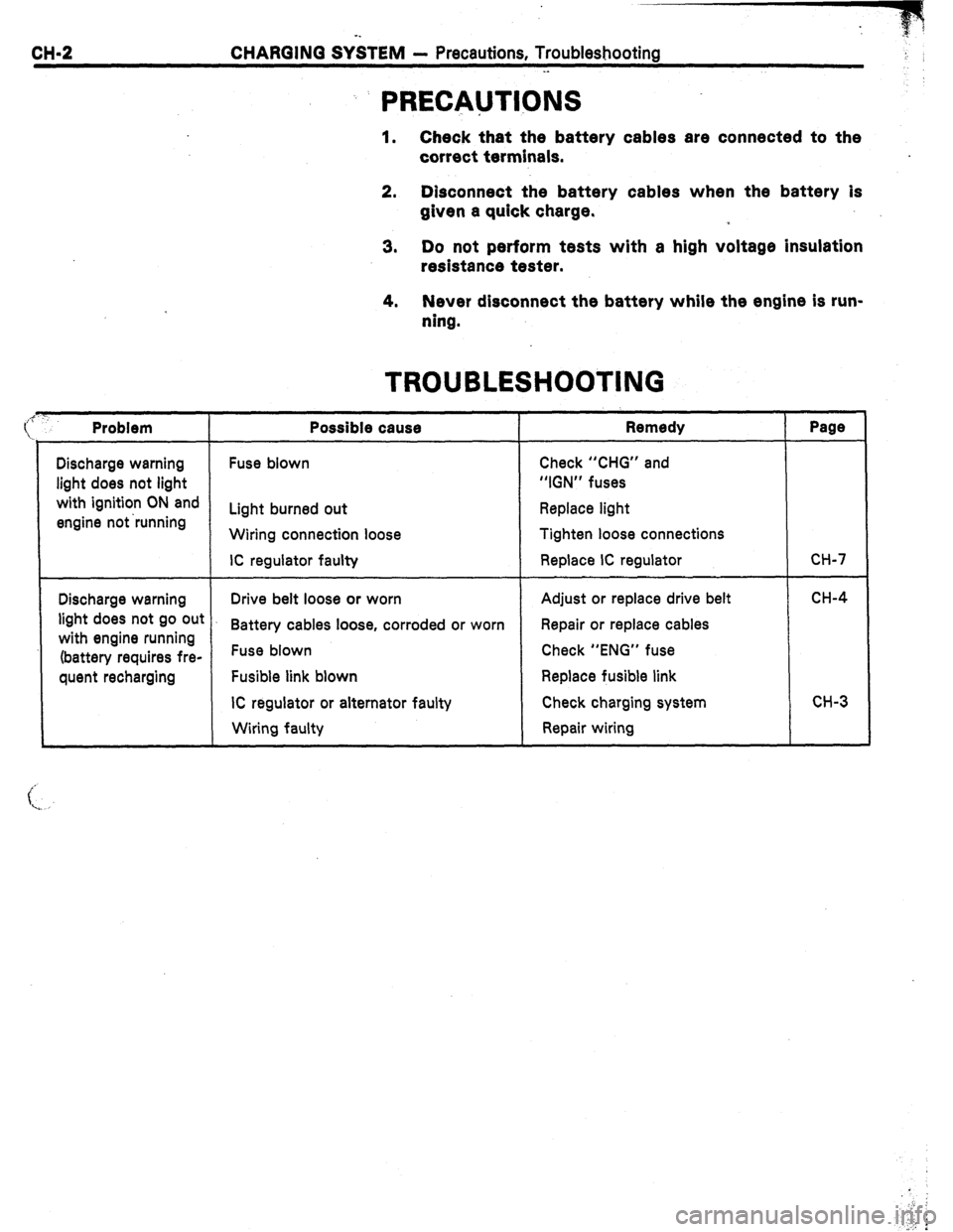
CH-2 CHARGING SY&EM - Precautions, Troubleshooting
._
: PRECAUTIONS
1. Check that the battery cables are connected to the
correct terminals.
2. Disconnect the battery cables when the battery is
given a quick charge.
3. Do not perform tests with a high voltage insulation
resistance tester.
4. Never disconnect the battery while the engine is run-
ning.
Discharge warning
light does not light
with ignition ON and
engine not ‘running
Problem
Discharge warning
light does not go out
with engine running
(battery requires fre-
quent recharging
Possible cause
Fuse blown
Light burned out
Wiring connection loose
IC regulator faulty
TROUBLESHOOTING
Remedy
Check “CHG” and
“IGN” fuses
Replace light
Tighten loose connections
Replace IC regulator
Drive belt loose or worn
Battery cables loose, corroded or worn
Fuse blown
Fusible link blown
IC regulator or alternator faulty
Wiring faulty Adjust or replace drive belt
Repair or replace cables
Check “ENG” fuse
Replace fusible link
Check charging system
Repair wiring
Page
CH-7
CH-4
CH-3
Page 37 of 346
![TOYOTA CELICA 1987 Service Repair Manual Circuit
Opening
Relay Fuel Pump Relay
“CHECK 1 f-- 1 ] : :
llll II :
: :
ENGINE”
Warning
Light ECU
I iIll
+-,llllllllllll
Electronic
Load Air Temp. Sensor
Check Connector 1 1 1 / 1 TOYOTA CELICA 1987 Service Repair Manual Circuit
Opening
Relay Fuel Pump Relay
“CHECK 1 f-- 1 ] : :
llll II :
: :
ENGINE”
Warning
Light ECU
I iIll
+-,llllllllllll
Electronic
Load Air Temp. Sensor
Check Connector 1 1 1 / 1](/manual-img/14/57451/w960_57451-36.png)
Circuit
Opening
Relay Fuel Pump Relay
“CHECK 1 f-- 1 ] : :
llll II :
: :
ENGINE”
Warning
Light ECU
I iIll
+-,llllllllllll
Electronic
Load Air Temp. Sensor
Check Connector 1 1 1 / 1 1 1 1 1 1 1 1
:uator
Igniter w/r-:’ ’
A/C Compressor
& 1 wTwy 1 To Charcoal Canister
Neutral Start
Switch (A/T)
Page 40 of 346
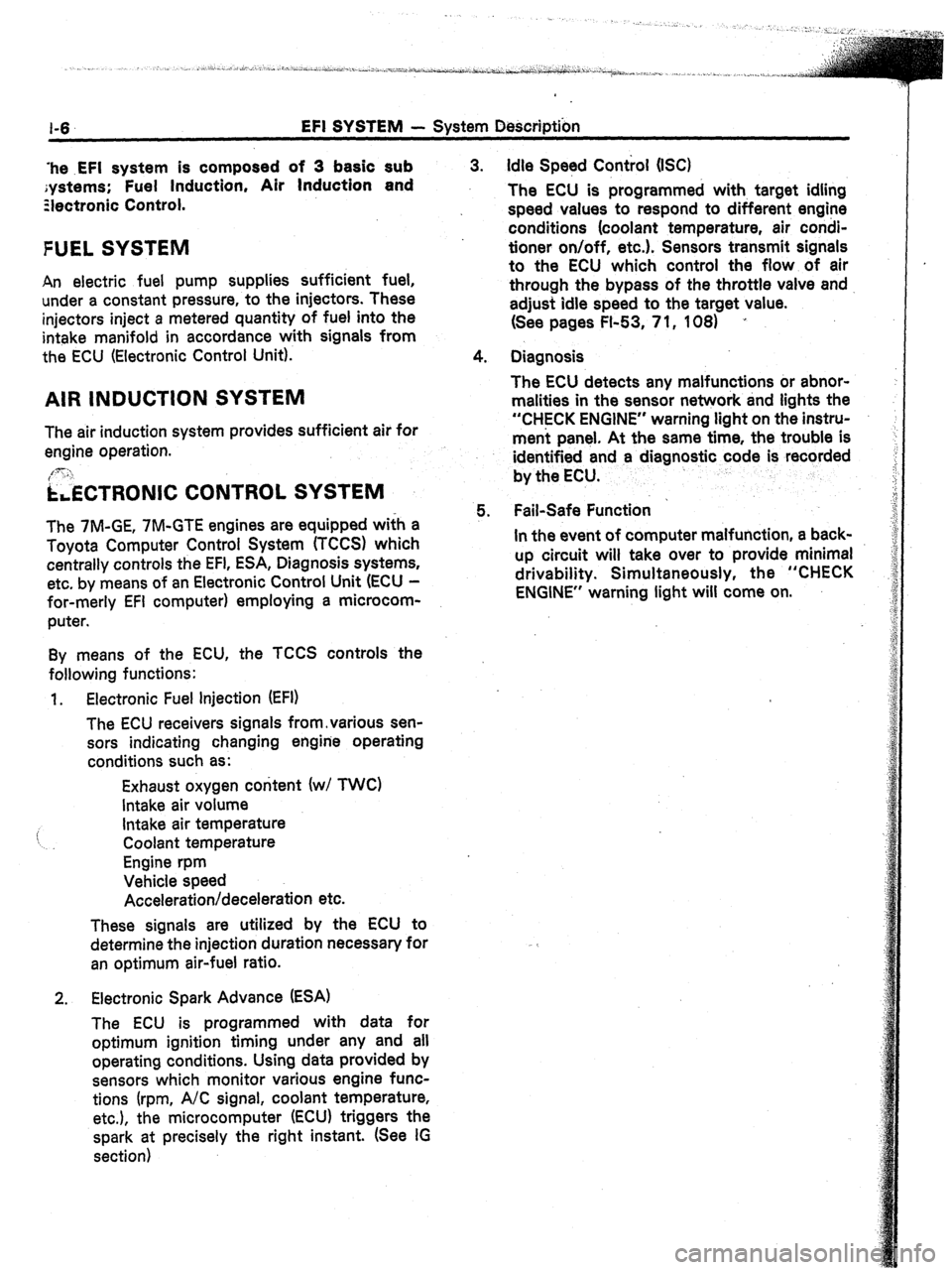
1-6 EFI SYSTEM - System Description
‘he .EFI system is composed of 3 basic sub
;ystems; Fuel Induction, Air Induction and
Ziectronic Control.
FUEL SYSTEM
An electric fuel pump supplies sufficient fuel,
under a constant pressure, to the injectors. These
injectors inject a metered quantity of fuel into the
intake manifold in accordance with signals from
the ECU (Electronic Control Unit).
AIR INDUCTION SYSTEM
The air induction system provides sufficient air for
engine operation.
[3: ‘I
i&TRONIC CONTROL SYSTEM
The 7M-GE, 7M-GTE engines are equipped wifh a
Toyota Computer Control System (TCCS) which
centrally controls the EFI, ESA, Diagnosis systems,
etc. by means of an Electronic Control Unit (ECU -
for-merly EFI computer) employing a microcom-
puter.
By means of the ECU, the TCCS controls the
following functions:
1. Electronic Fuel injection (EFI)
The ECU receivers signals from,various sen-
sors indicating changing engine operating
conditions such as:
Exhaust oxygen content (w/ TWC)
Intake air volume
i Intake air temperature
Coolant temperature
Engine rpm
Vehicle speed
Acceleration/deceleration etc.
These signals are utilized by the ECU to
determine the injection duration necessary for
an optimum air-fuel ratio.
2. Electronic Spark Advance (ESA)
The ECU is programmed with data for
optimum ignition timing under any and all
operating conditions. Using data provided by
sensors which monitor various engine func-
tions (rpm, A/C signal, coolant temperature,
etc.), the microcomputer (ECU) triggers the
spark at precisely the right instant. (See IG
section) 3. Idle Speed Control (IX)
The ECU is programmed with, target idling
speed values to respond to different engine
conditions (coolant temperature, air condi-
tioner on/off, etc.). Sensors transmit signals
to the ECU which control the flow of air
through the bypass of the throttle valve and
adjust idle speed to the target value.
(See pages FI-53, 7 1, 108) ’
4. Diagnosis
The ECU detects any malfunctions or abnor-
malities in the sensor network and tights the
“CHECK ENGINE” warning light on the instru-
ment panel. At the same time, the trouble is
identified and a diagnostic code is recorded
by the ECU.
5. Fail-Safe Function ’
In the event of computer malfunction, a back-
up circuit will take over to provide minimal
drivability. Simultaneously, the “CHECK
ENGINE” warning light will come on.
Page 41 of 346
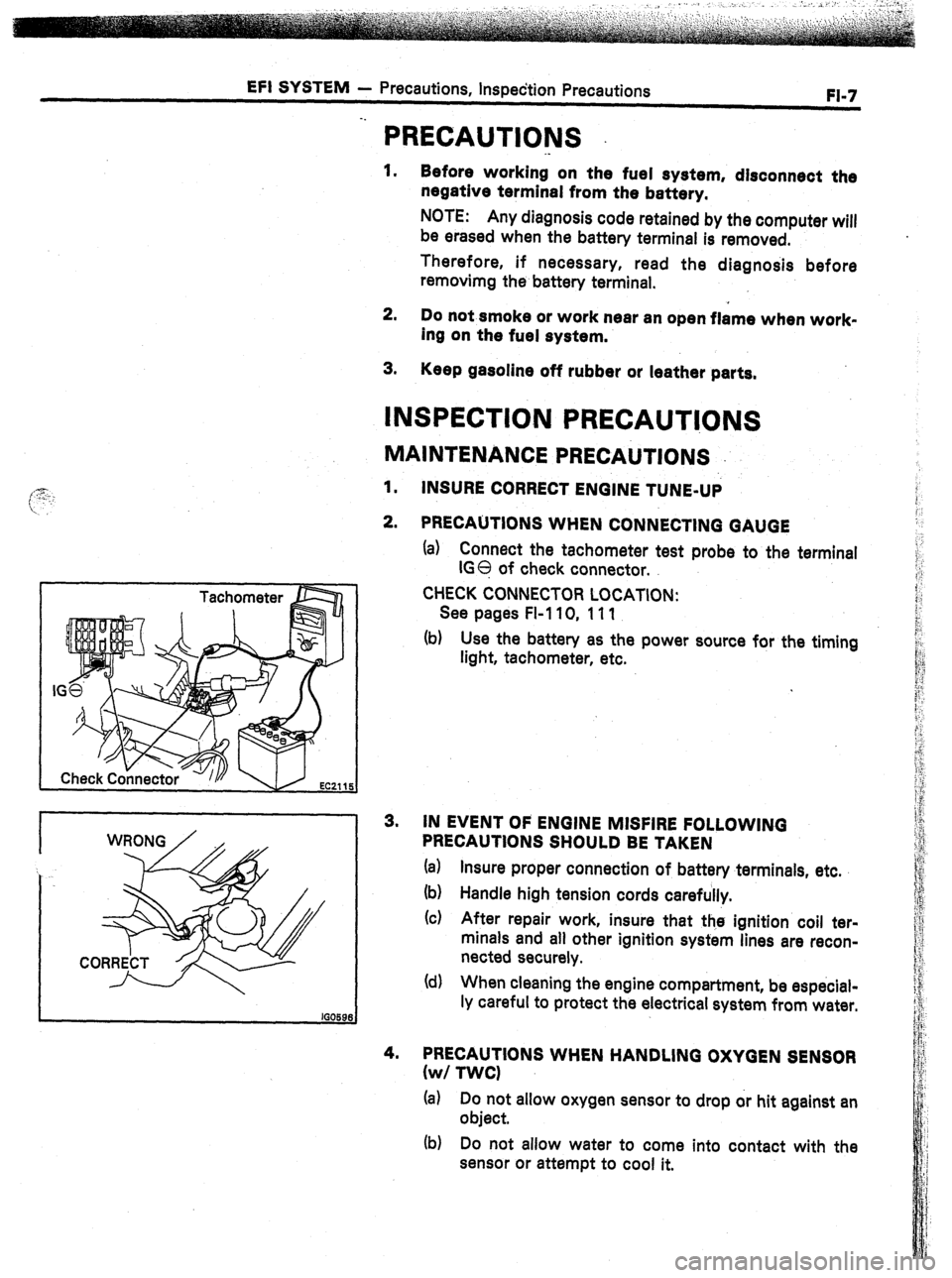
EFI SYSTEM
- Precautions, Inspection Precautions
FI-7
PRECAUTIONS
._
1. Before working on the fuel system, disconnect the
negative terminal from the battery.
NOTE: Any diagnosis code retained by the computer will
be erased when the battery terminal is removed.
Therefore, if necessary, read the diagnosis before
removimg the battery terminal.
2. Do not smoke or work near an open flame when work-
ing on the fuel system.
3. Keep gasoline off rubber or leather parts.
INSPECTION PRECAUTl.ONS
MAINTENANCE PRECAUTIONS
1. INSURE CORRECT ENGINE TUNE-UP
2. PRECAUTIONS WHEN CONNECTING GAUGE
(a) Connect the tachometer test probe to the terminal
IGO of check connector.
CHECK CONNECTOR LOCATION:
See pages FI-110, 111
(b) Use the battery as the power source for the timing
light, tachometer, etc.
3. IN EVENT OF ENGINE MISFIRE FOLLOWING
PRECAUTIONS SHOULD BE TAKEN
(a) Insure proper connection of battery terminals, etc.
(b) Handle high tension cords carefully.
(c) After repair work, insure that the ignition coil ter-
minals and all other ignition system lines are recon-
nected securely.
(d) When cleaning the engine compartment, be especial-
ly careful to protect the electrical system from water.
4. PRECAUTIONS WHEN HANDLING OXYGEN SENSOR
(w/ TWCI
(a) Do not allow oxygen sensor to drop or hit against an
object.
(b) Do not allow water to come into contact with the
sensor or attempt to cool it.
Page 46 of 346
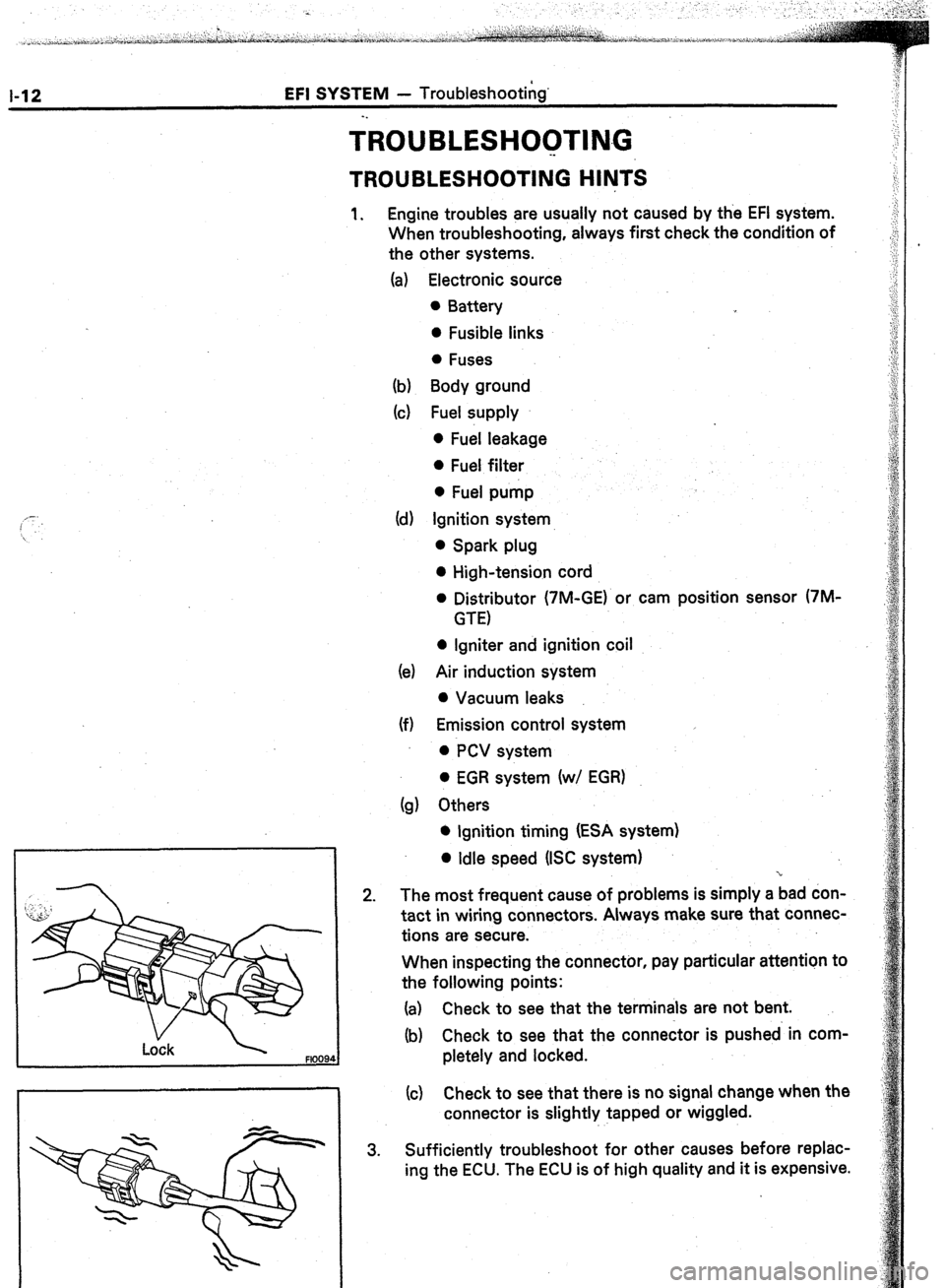
1-12 EFI SYSTEM - Troubleshooting’
FlO48
TROUBLESH~~TI~~G
. .
TROUBLESHOOTING HlhJTS
1. Engine troubles are usually not caused by the EFI system.
When troubleshooting, always first check the condition of
the other systems.
(a) Electronic source
0 Battery
0 Fusible links
0 Fuses
(b) Body ground
(cl Fuel supply
0 Fuel leakage
0 Fuel filter
0 Fuel pump
(d) Ignition system
0 Spark plug
0 High-tension cord
l Distributor (7M-GE) or cam position sensor (7M-
GTE)
0 Igniter and ignition coil
(e) Air induction system
0 Vacuum leaks
(f) Emission control system
0 PCV system
0 EGR system (w/ EGR)
(g) Others
l Ignition timing (ESA system)
0 Idle speed (ISC system)
-r
2. The most frequent cause of problems is simply a bad don-
tact in wiring connectors. Always make sure that connec-
tions are secure.
When inspecting the connector, pay particular attention to
the following points:
(a) Check to see that the terminals are not bent.
(b) Check to see that the connector is pushed in com-
pletely and locked.
(c) Check to see that there is no signal change when the
connector is slightly tapped or wiggled.
3. Sufficiently troubleshoot for other causes before replac-
ing the ECU. The ECU is of high quality and it is expensive.
Page 51 of 346
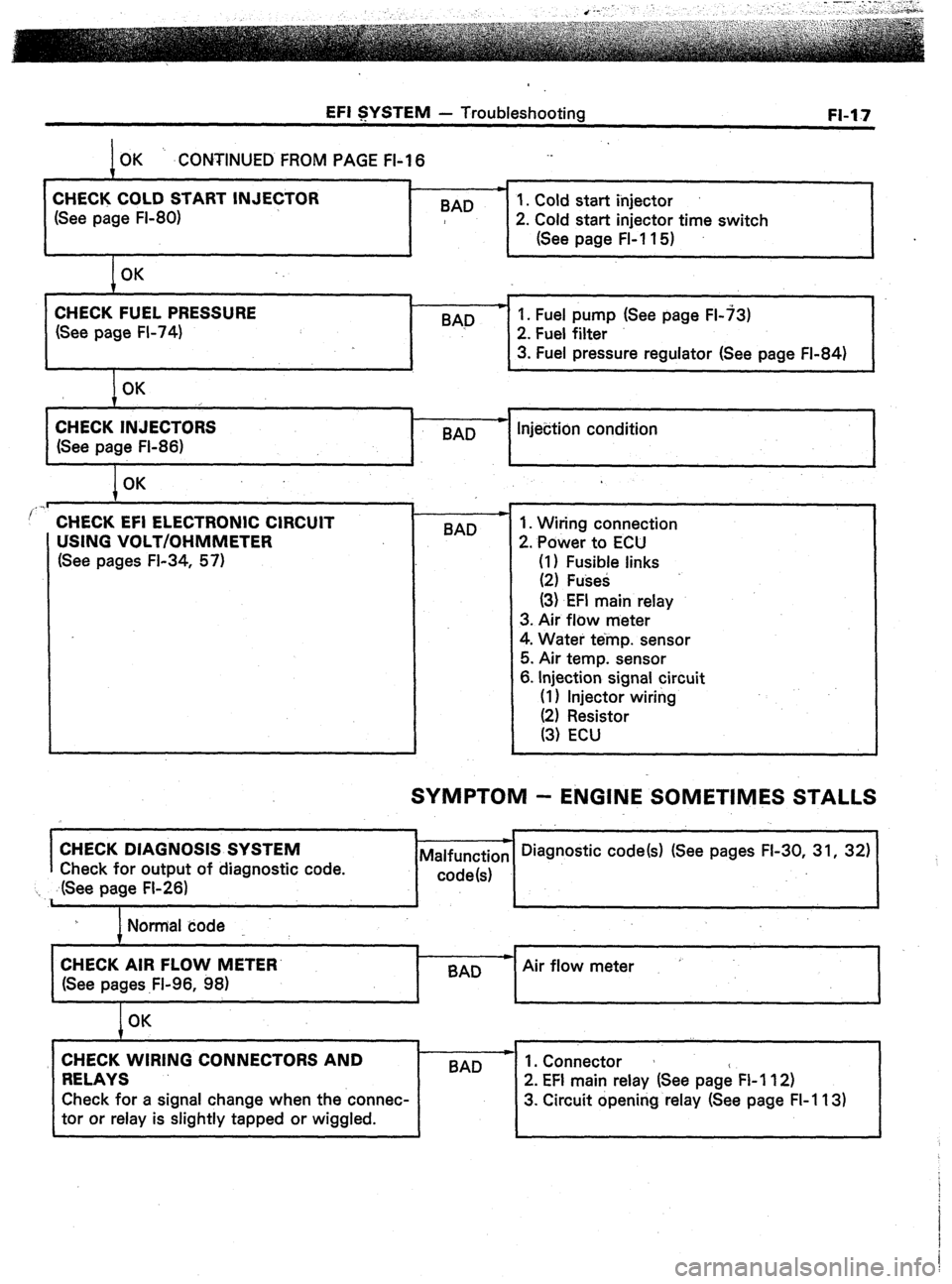
EFI SYSTEM - Troubleshooting
OK ‘. .CONTINUED FROM PAGE FI-I 6
m
CHECK COLD START INJECTOR
1. Cold start injector
(See page FI-80) BAD
2. Cold start injector time switch
(See page FL11 5)
OK FI-17
CHECK FUEL PRESSURE
(See page FI-74) BAD p 1. Fuel pump (See page FL73)
2. Fuel filter
3. Fuel pressure regulator (See page FI-84)
OK
CHECK INJECTORS
(See page FI-86) c
-
BAD Injection condition
I OK
..I
’ CHECK EFI ELECTRONIC CIRCUIT
USING VOLT/OHMMETER
(See pages FI-34, 57) BAD 1. Wiring connection
2. Power to ECU
(I) Fusible links
(2) Fuses
(3) EFI main relay
3. Air flow meter
4. Water temp. sensor
5. Air temp. sensor
6. Injection signal circuit
(I 1 Injector wiring
SYMPTOM - ENGINE SOMETIMES STALLS
I
CHECK DIAGNOSIS SYSTEM
Check for output of diagnostic code.
‘I ,. ,dSee page FI-26)
I Normal code
I
CHECK AIR FLOW METER’
Air flow meter
(See pages .Fl-96, 98)
I
OK
CHECK WIRING CONNECTORS AND
RELAYS 1 BAD --
2’ EFI main relay (See page FI 112)
Check for a signal change when the connec- 3. Circuit opening relay (See page FI-113)
tor or relay is slightly tapped or wiggled.
Page 59 of 346
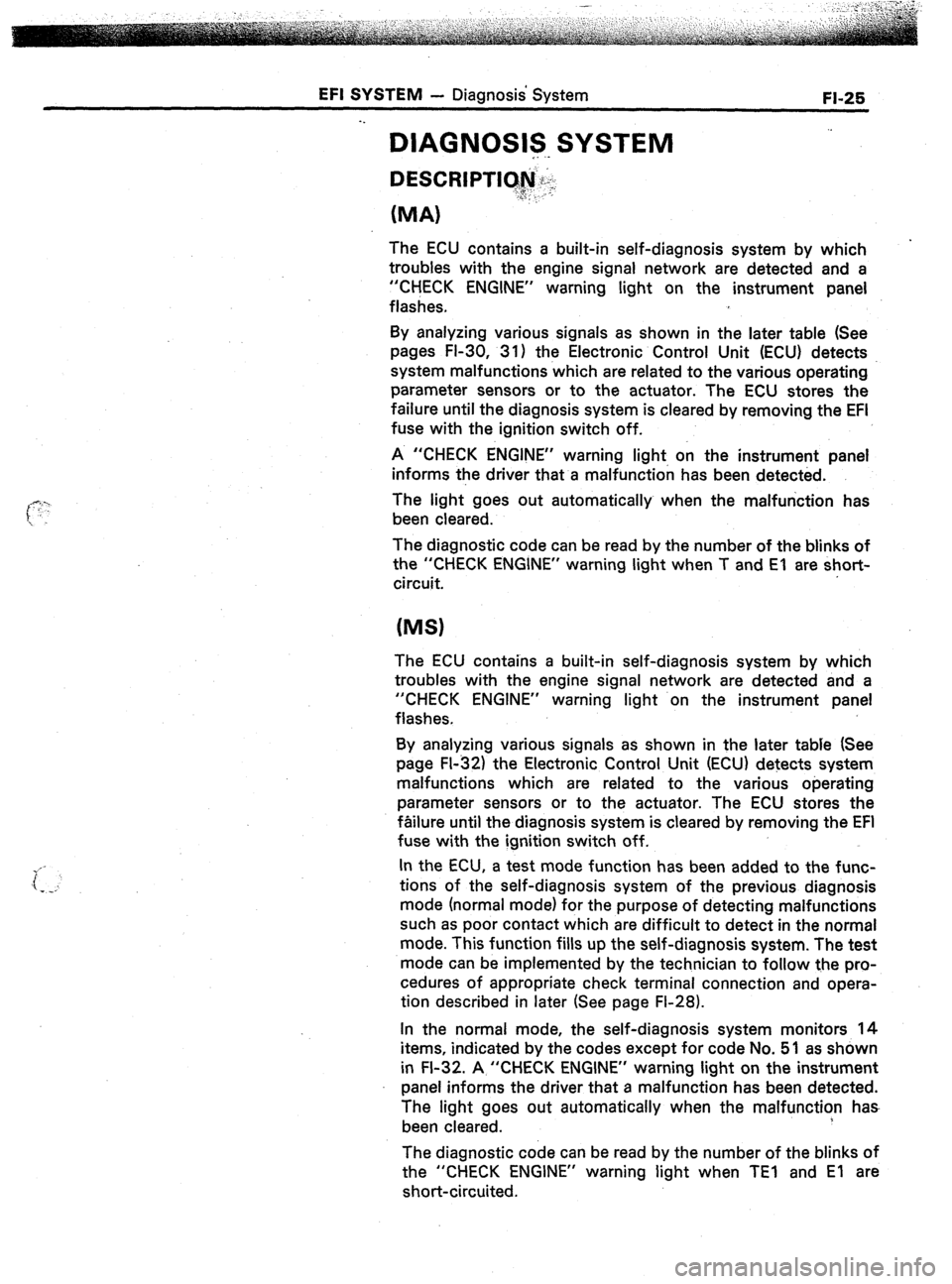
EFI SYSTEM - Diagnosis System
. .
DIAGNOSIS SYSTEM
__ --
FL25
(MA)
The ECU contains a built-in self-diagnosis system by which
troubles with the engine signal network are detected and a
“CHECK ENGINE” warning light on the instrument panel
flashes,
By analyzing various signals as shown in the later table (See
pages Fl-30, 31) the Electronic Control Unit (ECU) detects
system malfunctions which are related to the various operating
parameter sensors or to the actuator. The ECU stores the
failure until the diagnosis system is cleared by removing the EFI
fuse with the ignition switch off.
A “CHECK ENGINE” warning light on the instrument panel
informs the driver that a malfunction has been detected.
The light goes out automatically when the malfunction has
been cleared.
The diagnostic code can be read by the number of the blinks of
the “CHECK ENGINE” warning light when T and El are short-
circuit.
(MS)
The ECU contains a built-in self-diagnosis system by which
troubles with the engine signal network are detected and a
“CHECK ENGINE” warning light on the instrument panel
flashes.
By analyzing various signals as shown in the later table (See
page FI-32) the Electronic Control Unit (ECU) detects system
malfunctions which are related to the various operating
parameter sensors or to the actuator. The ECU stores the
failure until the diagnosis system is cleared by removing the EFI
fuse with the ignition switch off.
In the ECU, a test mode function has been added to the func-
tions of the self-diagnosis system of the previous diagnosis
mode (normal mode) for the purpose of detecting malfunctions
such as poor contact which are difficult to detect in the normal
mode. This function fills up the self-diagnosis system. The test
mode can be implemented by the technician to follow the pro-
cedures of appropriate check terminal connection and opera-
tion described in later (See page FI-28).
In the normal mode, the self-diagnosis system monitors 14
items, indicated by the codes except for code No. 51 as shown
in FI-32. A “CHECK ENGINE” warning light on the instrument
panel informs the driver that a malfunction has been detected.
The light goes out automatically when the malfunction has
been cleared.
The diagnostic code can be read by the number of the blinks of
the “CHECK ENGINE” warning light when TEl and El are
short-circuited.
Page 60 of 346
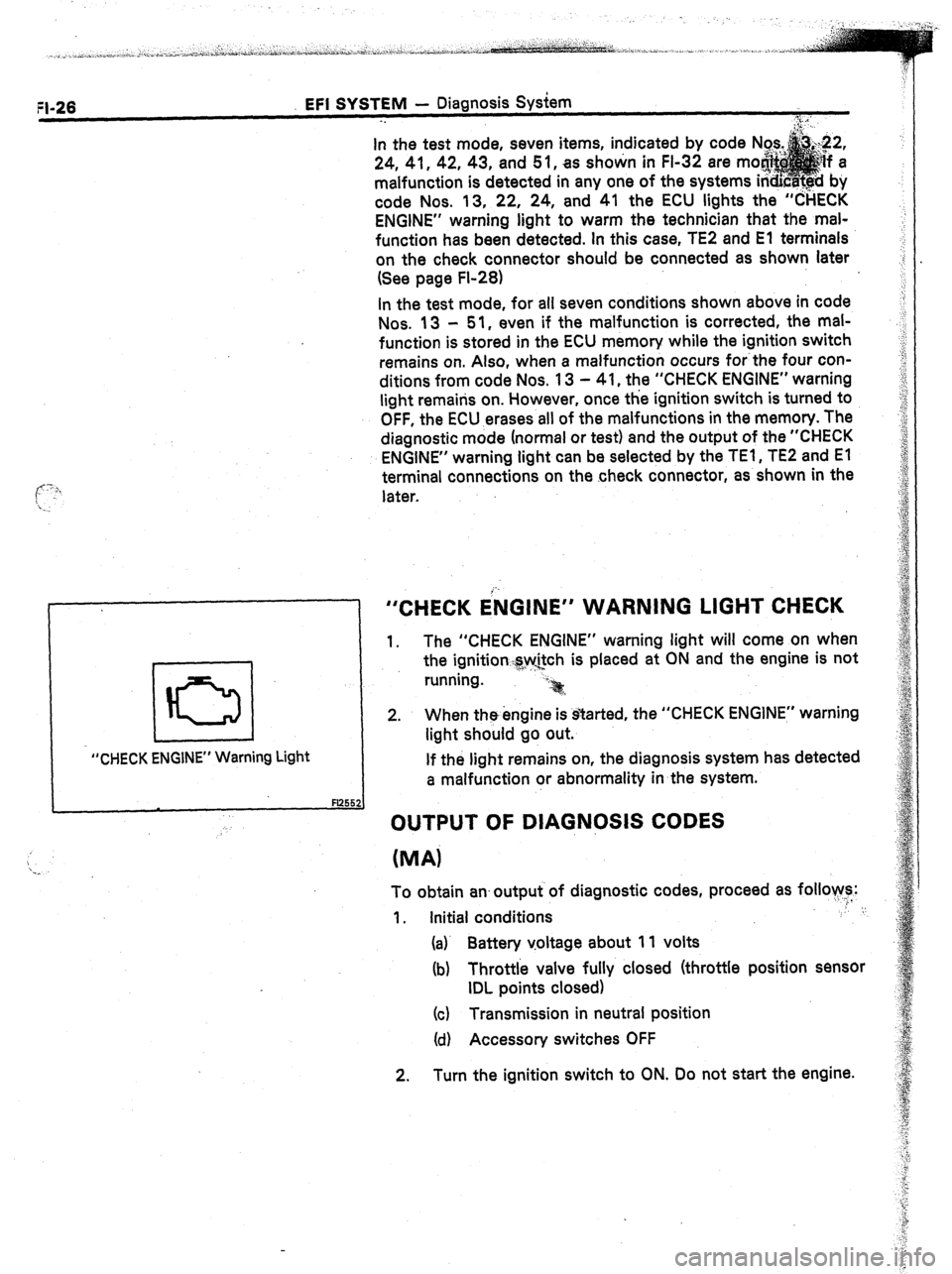
FI-26 EFI SYSTEM - Diagnosis System
-.
i
“CHECK ENGINE” Warning Light In the test mode, seven items, indicated by code
24, 41, 42, 43, and 5 1, as shown in FI-32 are m
malfunction is detected in any one of the systems
code Nos. 13, 22, 24, and 41 the ECU lights the “CHECK
ENGINE” warning light to warm the technician that the mal-
function has been detected. In this case, TE2 and El terminals
on the check connector should be connected as shown later
(See page FI-28)
In the test mode, for all seven conditions shown above in code
Nos. 13 - 51, even if the malfunction is corrected, the mal-
function is stored in the ECU memory while the ignition switch
remains on. Also, when a malfunction occurs for-the four con-
ditions from code Nos. 13 - 41, the “CHECK ENGINE” warning
light remains on. However, once the ignition switch is turned to
OFF, the ECU erases all of the malfunctions in the memory. The
diagnostic mode (normal or test) and the output of the “CHECK
ENGINE” warning light can be selected by the TEl , TE2 and El
terminal connections on the check connector, as shown in the
later.
“CHECK ENGINE” WARNING LIGHT CHECK
1. The “CHECK ENGINE” warning light will come on when
the ignitiorqw:@ch is placed at ON and the engine is not
running. -y.
2. When the engine is started, the “CHECK ENGINE” warning
light should go out.
If the light remains on, the diagnosis system has detected
a malfunction or abnormality in the system.
OUTPUT OF DIAGNOSIS CODES
(MA)
To obtain an output of diagnostic codes, proceed as follows:
1. Initial conditions ,’
(a)’ Battery voltage about 11 volts
(b) Throttle valve fully closed (throttle position sensor
IDL points closed)
(cl Transmission in neutral position
(d) Accessory switches OFF
2. Turn the ignition switch to ON. Do not start the engine.